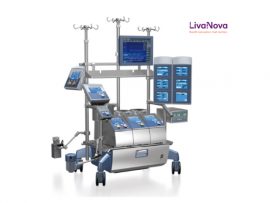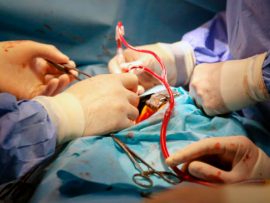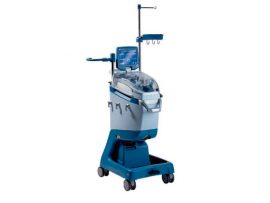Abstract The objective of this study was to determine whether treatment with human fibrinogen concentrate decreases the need for component blood therapy and blood loss in neonate and infant patients..
Read MoreAbstract Objectives Little is known about the safety and clinical utility of retrograde autologous priming (RAP) in patients undergoing minimally invasive mitral valve surgery. We hypothesized that RAP would increase..
Read MoreAbstract Study objective On-pump cardiac surgery is associated with a high risk of acute kidney injury (AKI), which can substantially affect risk of mortality and morbidity depending on its severity...
Read MoreAbstract Extracorporeal membrane oxygenation (ECMO) requires anticoagulation to prevent clotting when the patient’s blood contacts the circuit. Unfractionated heparin (UFH) usually prevents clotting but can cause life-threatening bleeding. An anticoagulant..
Read MoreAbstract OBJECTIVES The pathophysiology of delirium after cardiac surgery is complex. The present study aims to determine perioperative risk factors and construct a scoring system for postoperative delirium based..
Read MoreAbstract Objective: To assess the potential benefits of minimally invasive aortic valve replacement (MIAVR) compared with conventional AVR (CAVR) by examining short-term outcomes. Methods: A systematic search identified randomized trials comparing MIAVR..
Read MoreAbstract Background The number of elderly patients undergoing cardiac surgery is increasing. Age greater than 80 years has been identified as a strong independent risk factor for short- and long-term..
Read MoreAbstract Objectives Cardiopulmonary bypass (CPB) predisposes young children to coagulopathy. The authors evaluated possible effects of CPB priming fluids on perioperative bleeding in pediatric cardiac surgery. Design Meta-analysis and systematic..
Read MoreAbstract Purpose Many believe that blood pressure management during cardiac surgery is associated with postoperative outcomes. We conducted a systematic review and meta-analysis of randomized controlled trials (RCTs) to determine..
Read MoreBlood Protection Method: Retrograde Autologous Prime In order to carry out open heart surgery, the functions of the heart and lungs must be stopped and the blood inside the..
Read MoreAbstract Postpartum hemorrhage (PPH) can lead to substantial blood loss that compromises maternal hemodynamic stability and consequently cause severe maternal complications such as organ dysfunction or death. Intraoperative cell salvage..
Read MoreAbstract Retrograde autologous priming (RAP) is a process used to reduce hemodilution associated with the initiation of cardiopulmonary bypass (CPB). Previous studies have reported potential benefits to RAP; however, many..
Read MoreAbstract Decrease of patient’s hematocrit level is a natural process which occurs during the initiation of cardiopulmonary bypass. To some extent it is a beneficial occurrence, but excessive hematocrit decrease..
Read MoreAbstract Heart disease is among the most important health problems in our country and in the world. Heart diseases are widely repaired in adults, children and newborns with open heart..
Read MoreAbstract Objective Deep hypothermic circulatory arrest (DHCA) in aortic surgery is associated with morbidity and mortality despite evolving strategies. With the advent of antegrade cerebral perfusion (ACP), moderate hypothermic circulatory..
Read MoreAbstract Background Intraoperative blood salvage (IBS) is regarded as an alternative to allogeneic blood transfusion excluding the risks associated with allogeneic blood. Currently, IBS is generally avoided in tumor surgeries..
Read MoreAbstract Purpose The primary aim of this study was to examine the effects of two oxygenator systems on major adverse events and mortality. Methods A total of 181 consecutive patients..
Read MoreAbstract Purpose of review Major bleeding in cardiac surgery is commonly encountered, and, until recently, most frequently managed with fresh frozen plasma (FFP). However, a Cochrane review found this practice..
Read MoreAbstract Vacuum-assisted venous drainage (VAVD) was proposed to optimize venous drainage during bypass through femoral venous cannulation. It is currently used in both adult and pediatric surgery when siphon gravity..
Read MoreAbstract Background Previous studies have shown that preoperative anaemia in patients undergoing cardiac surgery is associated with . However, most of these studies were retrospective, had a relatively small sample size,..
Read MoreAbstract Objectives The assessment of platelet function in cardiac surgery patients who recently received dual-antiplatelet therapy is considered in the existing guidelines. Among available devices, Multiplate (MP) and ROTEM Platelet..
Read MoreAbstract Background. Temporary extracorporeal membrane oxygenation (ECMO) support for high-risk percutaneous coronary intervention (PCI) has been described in select patients, and data are limited on the CardioHELP device (Maquet). The..
Read MoreAbstract Background The use and effectiveness of intraoperative cell salvage has been analyzed in many surgical specialties. Until now, no data exist evaluating the efficacy of intraoperative cell salvage in..
Read MoreAbstract Objective Previous studies reported a poor outcome in patients with coronavirus 2019 (COVID-19) undergoing cardiac surgery. Complications most frequently described were respiratory failure, renal failure, and thromboembolic events. In..
Read MoreIntroduction National health expenditures rose to 3.8 trillion dollars in 2019, 18% of gross domestic product, and are continuing to rise at an unsustainable rate. Aggregate costs for hospitalizations associated with..
Read MoreAbstract Background management during venoarterial (ECMO) is particularly difficult in postcardiotomy shock patients given a significant bleeding risk. We sought to determine the effect of treatment on bleeding and thrombosis risk for..
Read MoreAbstract Background There is now extension of minimally invasive techniques to involve concomitantly aortic and mitral valves through a single small incision. We share our experience in such surgeries through..
Read MoreAbstract Background and objectives The increment in a patient’s haemoglobin level is based upon the haemoglobin content of the transfused RBC units. The total haemoglobin present in the blood bags..
Read MoreAbstract Background Chronic thromboembolic pulmonary hypertension (CTEPH) is optimally treated by pulmonary thromboendarterectomy (PEA). Treatment effectiveness has been evaluated principally using single-center series. Data from the Society of Thoracic Surgeons..
Read MoreAbstract Introduction The aim of the current study was to evaluate the impact of increased blood lactate levels during cardiopulmonary bypass (CPB) on immediate results in patients who underwent open..
Read More












